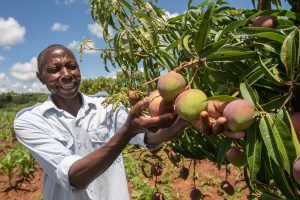Siaya County Governor James Orengo and Cabinet Secretary for Agriculture Mithika Linturi at Kilimo House. Photo Credit: Henry
By Henry Owino, August 2, 2023, Farmers have been cautioned against selling their farm produce at low prices and urged to keep stock for the right time and sell it at better prices.
James Orengo, Siaya County Governor says that most counties in Kenya have not harvested enough of their produce compared to Siaya County.
He attributed the bumper yields to mechanization of agriculture in the county and the provision of certified seeds, soil sampling, revamp of ecological farming and observing rainfall patterns in the wake of climate change.
The governor noted that among the six Sub-counties in Siaya; Bondo, Gem, Alego-Usonga, Ugunja and Ugenya, Rarieda registered high yields following the agriculture mechanization. He however expressed fear that the smallholder farmers may sell the farm produce at very low prices.
He noted that some farmers have already started selling their maize below Ksh 100 per 2 kilograms tin (gorogoro) saying that will in near future start buying the same at Ksh 230 or even more.
Orengo alerted residents that buyers who purchase several sacks of maize, millet and beans cheaply now, will sell to them same cereals at exorbitant prices later. He therefore called upon the County Government officials to convene talks on how to prevent the farmers from exploitation by opportunists who would want to buy their maize at low prices.
“I went to visit a certain lady within Siaya County whom I found threshing maize manually and sun drying at her home. When asked her about outcome of her farming, she narrated to me a long story on hunger and poverty that she could not wait any longer but to sell the maize and meet certain pressing needs of her own,” Orengo stated.
The Governor wondered why the woman was in a hurry threshing the maize which had not dried properly. It is a big loss to farmers especially after toiling hard and spending much only for cartels to benefit by purchasing the produce at these low prices.
“It was at that point I knew there is going to be a problem of food despite the county’s bounteous harvest this season. So, we are going to organize as County Government to see how we can buy maize from our local smallholder farmers at reasonable prices,” the Governor disclosed.
The County boss pleaded with the farmers to be a little bit cautious to avoid facing hunger in the near future. He explained it is because areas which have been feeding Siaya County have registered relatively low yield this season, adding that the cost of living in the country is currently unpredictable.
Orengo hinted the County Government will organize on how to buy the maize at a reasonable price and then store it for future use. That way it will ensure the county does not face food shortage in the near future.
The Siaya County Governor advised residents also to factor in the cost of production and other expenses involved during farming before selling the produce. He challenged the residents that hunger of several months cannot be solved with a few hundreds of shillings considering high cost of living in the country now.
Kevin Osido from Rarieda Sub-county conquered with the Governor sentiments while claiming it is so due to poverty and hunger driving people crazy. He asserts that most people depend on farm produce to sort out some emergency issues like school fee.
“But let me also plead with young people who even steal stored cereals of their parents or guardians in granaries to sell for nutty reasons. For instance, to buy motorbike fuel, buy credit cards, seduce girlfriends, buy latest attires, entertain friends in drinking spree among others which is theft and wasteful,” Osido cautioned. It is a curse before God,” he added.
Osido revealed current cost of 2kg tin (gorogoro) ranges between Ksh 200 to Ksh 230 depending on the location and quantities one buys in terms of wholesale or retail. Nevertheless, these plenty harvests have cut down prices between Ksh 50 to Ksh 80 especially within homes.
He pointed out his present maize surplus are approximately five bags set for sale beginning late October or early November this year. He however, said he usually targets institutions which pay much better compared to individual buyers or open market prices.







